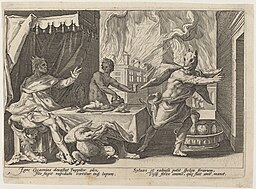We associate Halloween with many supernatural creatures, including werewolves. However, these werewolves have a long history in folklore predating their association with Halloween. Werewolves have been featured in literature for thousands of years, including the novel Satyricon by Petronius. Werewolves remain popular in modern fiction as well as in films and television series. Unlike vampires, who frequently headline supernatural narratives, werewolves seem to be more commonly featured in supporting roles within the genre, like the werewolves Jacob in The Twilight Saga and Wayne in Hotel Transylvania. If you enjoy a good werewolf story, read on for a description of some resources that will leave you howling for more—all available in WorldCat, of course!
Metamorphoses
The myth of King Lycaon is not the earliest werewolf story but is an important exemplar of the wolf transformation being used as a punishment. In Metamorphoses, the Roman poet Ovid describes how the god Jupiter transformed Lycaon into a wolf as a punishment for attempting to trick the disguised Jupiter into eating human flesh. Several 16th-century editions of Metamorphoses include illustrations of this myth, but one of the best may be from an incomplete project by Dutch engraver Henrick Goltzius to provide 300 illustrations for Metamorphoses. Fifty-Two Engravings Illustrating Ovid’s Metamorphosis contains illustrations he completed, including one depicting the Lycaon myth. For readers who love etymology, yes, there is a connection between King Lycaon’s name and lycanthrope. The word lycanthrope derives from two Greek words: λύκος (wolf) and ἄνθρωπος (man).
The Phantom Ship
Most werewolves in stories were male until the 1839 publication of Frederick Marryat’s Gothic novel The Phantom Ship, which is available to read online at HathiTrust. In chapter 39, the character Hermann Krantz tells a story about a mysterious woman named Christina who married his father and they discovered could transform into a white wolf. It is noteworthy that Christina came from Transylvania, which would be the setting of the 1897 novel Dracula. This chapter has been published as a short story called “The White Wolf of the Hartz Mountains” in anthologies such as Terrifying Transformations: an Anthology of Victorian Werewolf Fiction, 1838-1896.
This is a horror story with Christina beating her stepchildren in her human form and killing Krantz’s siblings in her wolf form. Like many supernatural creatures described in Gothic fiction, the female werewolf in The Phantom Ship is evil rather than the complex depictions of cursed humans in later literature.
While The Phantom Ship lacks the popularity of other Gothic novels like Dracula and Frankenstein, the contribution of the female werewolf character paved the way for another female werewolf in my favorite modern werewolf story, Bitten by Kelley Armstrong. The novel’s main character is Elena Michaels, the only known female werewolf. Elena struggles to reconcile her human and werewolf sides in this novel and its sequels. I don’t want to spoil the story for those of you interested in reading the novel, so I’ll just say that Elena stands out in the pack.
Teen Wolf
The motion picture Teen Wolf, directed by Rod Daniel and starring Michael J. Fox, may not be a horror film classic, but this coming-of-age comedy provides a bold twist to the typical werewolf story. High school student Scott Howard’s lycanthropy is an asset instead of a curse. As a werewolf, Howard uses his superior athletic abilities to help his basketball team win games, and he becomes very popular. With popularity comes arrogance, and thus Howard learns to be himself and work with his teammates. As a child of the 80s, I remember this film fondly for its simplistic storytelling. Also, unlike other supernatural movies from the same time period, this movie never gave me nightmares.
There is something for everyone in werewolf stories—horror, comedy, bildungsroman, and paranormal romance. If your Halloween plans are not already made, consider enjoying a good werewolf tale. Happy Halloween!
Kate James is the Program Coordinator, Metadata Engagement, in OCLC Global Product Management. Her favorite RDA entity is Nomen, and her favorite LC class number is SF429.C3.

Thanks so much, Kate, for such a fun post! It was wonderful to learn about older and new werewolf stories. This blog post was definitely a “treat” on Halloween! 🙂
Loved your article. I think I will give Dracula a try.